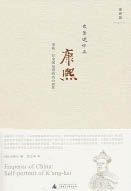An American Historian Renowned for Telling Chinese Stories
An American Historian Renowned for Telling Chinese Stories
By staff reporter LIU YI

Emperor of China:
Self-Portrait of K'ang-Hsi
Author: Jonathan D. Spence
194 pages, hardcover
RMB 30
Published by Guangxi Normal University Press in 2011
JONATHAN Spence, Sterling Professor of history at Yale University, is a controversial figure in academic circles because his history books are so popular with the public they become bestsellers.
Spence writes for English-speaking readers, but he has a large fan base in China. Chinese translations of his books abound, but vary in quality. Since late 2010, Guangxi Normal University Press has been undertaking an ambitious plan – to re-publish Spence's 13 books on China. Reliable and excellent translations were assembled for copyediting. Only three books have been published so far, but they have stirred up an energetic response from critics and readers.
The most striking work is Emperor of China: Self-Portrait of K'ang-Hsi. Emperor K'ang-Hsi (1654-1722), or Kangxi as he is commonly known today, is a figure widely researched in academic circles, but there is no work like this one. Against everyone's expectations, Spence used the first-person voice. There is not even a coherent narrative of events. What's more, there is neither rationale for action, nor second-guessing of motives. Like a film montage, the author scraped different scenes together to reveal the emperor's inner world.
Unlike most autobiographies, the events in this book are not chronological. Instead, the life of the emperor was put into a more personal and emotional structure, with five different layers reconstructing his complex inner world.
The first chapter "In Motion" is devoted to Kangxi's keen delight in traveling and hunting, a respite from his rigidly scheduled life. The second chapter "Ruling" reflects his thoughts on the economic, bureaucratic and educational systems. In the third chapter "Thinking," readers get a sense of the emperor's inquiring mind. He launched a huge encyclopedia program, and also studied geometry, mechanics, astronomy and optics with foreign missionaries. The fourth chapter "Growing Old" is a collection of prescriptions and recipes. Like many emperors in Chinese history, Kangxi was determined to find ways to live longer. He had an enormous and open affection for his grandmother and sons which was rarely seen in other rulers. The fifth chapter "Sons" reveals an old emperor's disappointment and sorrow. Though he cherished his close relationship with his sons, power had corroded it and eventually drew them all into a family tragedy.
At first glance, the book looks more like a collection of essays in the typical Spence style, which has been criticized by many. Christianity Today used to call Spence "the Picasso of Chinese studies." In historical reconstruction, a field which values serious textual research and analysis, this sounds like a back-handed compliment to the former president of the American Historical Association.
Knowing something about Spence and Chinese culture, avid readers might not be surprised by his style of writing. Born in London in 1936, Spence adopted a Chinese name when he was young – "Shi Jing Qian." "Shi" is the transliteration of his surname, and also means history in Chinese; "Jing" means respect, and "Qian" refers to Sima Qian (ca. 145 - 86 BC), author of the biographical Historical Records and the greatest historian in China. His vivid writings about the past are composed of appealing stories.
Like Sima Qian, Spence believes "history" should never equate to dull numbers and cold facts. The history is the history of people, with real emotions, so he transforms history into story. He writes about the life of an emperor, a hermit (Return to Dragon Mountain: Memories of a Late Ming Man), and a countrywoman living in the 17th century (The Death of Woman Wang). People's joys, sorrows, pleasures and anger are key to understanding what real history is about.
But "telling a story" is not writing a script. At the outset of Emperor of China: Self-Portrait of K'ang-Hsi, the emperor proudly narrates that he raises rare birds in the garden and grows vegetables and fruit trees himself. This is beyond many readers' expectations, but not groundless imagination. It is based on five pieces of historical material, including Kangxi's decrees, official historical records and the diaries of a close courtier.
The material revealed an emperor's feelings via several words and phrases scattered throughout voluminous documents. It required great patience, careful research and sensitive judgment to sort out and integrate the fragments into a whole picture of the man's life. In this sense, Spence's works are of great academic value, though they lack traditional analysis.
In fact, the emotional and literary writing style explains exactly how Spence could rouse Western interests in Chinese history. His characters are thousands of miles and hundreds of years away from the lives of modern American people. But life's experience and the consistency of human emotions are beyond time, place or nationality.
Spence's work has become one of the standard textbooks on Chinese history in the U.S., and his bestsellers exert a profound influence on Western readers' understanding of China. Some critics say Spence is the most influential sinologist in the U.S. after John Fairbanks, and if Fairbanks constructed the framework of Chinese history, then Spence built its walls and roofs.
Services
Economy
- Eco-agriculture and Eco-tourism Power Nanchang’s Green Development
- Balance Environmental Protection and Economic Prosperity – Nanchang Looks to European Technology for Green Development
- Sustainable Growth Requires Wiser Energy Use
- Chinese Economy: On the Path of Scientific Development
- China's Economy over the Last Ten Years

